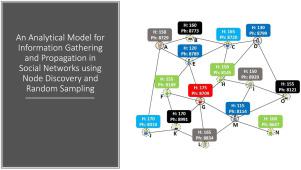Data & Knowledge Engineering ( IF 2.7 ) Pub Date : 2020-09-08 , DOI: 10.1016/j.datak.2020.101852 Samant Saurabh , Sanjay Madria , Anirban Mondal , Ashok Singh Sairam , Saurabh Mishra

|
In this paper, we propose an analytical model for information gathering and propagation in social networks using random sampling. We represent the social network using the Erdos–Renyi model of the random graph. When a given node is selected in the social network, information about itself and all of its neighbors are obtained and these nodes are considered to be discovered. We provide an analytical solution for the expected number of nodes that are discovered as a function of the number of nodes randomly sampled in the graph. We use the concepts of combinatorics, probability, and inclusion–exclusion principle for computing the number of discovered nodes. This is a computationally-intensive problem with combinatorial complexity. This model is useful when crawling and mining of the social network graph is prohibited. Our work finds application in several important real-world decision support scenarios such as survey sample selection, construction of public directory, and crowdsourced databases using social networks, targeted advertising, and recommendation systems. It can also be used for finding a randomized dominating set of a graph that finds applications in computer networks, document summarization, and biological networks. We have evaluated the performance both analytically as well as by means of simulation, and the results are comparable. The results have an accuracy of around 96% for random graphs and above 87% for the power-law graphs.
中文翻译:

使用随机图的社交网络中信息收集和传播的分析模型
在本文中,我们提出了一种使用随机抽样的社交网络中信息收集和传播的分析模型。我们使用随机图的Erdos-Renyi模型表示社交网络。当在社交网络中选择给定节点时,将获取有关其自身及其所有邻居的信息,并认为这些节点已被发现。我们为发现的预期节点数提供了一个解析解决方案,该期望数是根据图中随机采样的节点数而得出的。我们使用组合学,概率和包含-排除原理的概念来计算发现的节点数。这是具有组合复杂性的计算密集型问题。当禁止对社交网络图进行爬网和挖掘时,此模型很有用。我们的工作在一些重要的现实世界决策支持场景中得到了应用,例如调查样本的选择,公共目录的构建以及使用社交网络,针对性广告和推荐系统的众包数据库。它也可以用于查找图的随机控制集,以找到在计算机网络,文档摘要和生物网络中的应用。我们已经通过分析和仿真评估了性能,结果是可比的。对于随机图,结果的准确性约为96%,对于幂律图,其准确性为87%以上。它也可以用于查找图的随机控制集,以找到计算机网络,文档摘要和生物网络中的应用。我们已经通过分析和仿真评估了性能,结果是可比的。对于随机图,结果的准确性约为96%,对于幂律图,其准确性为87%以上。它也可以用于查找图的随机控制集,以找到计算机网络,文档摘要和生物网络中的应用。我们已经通过分析和仿真评估了性能,结果是可比的。对于随机图,结果的准确性约为96%,对于幂律图,其准确性为87%以上。











































 京公网安备 11010802027423号
京公网安备 11010802027423号